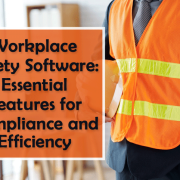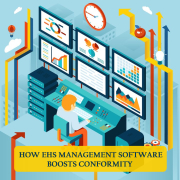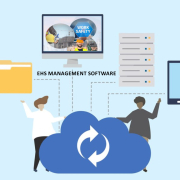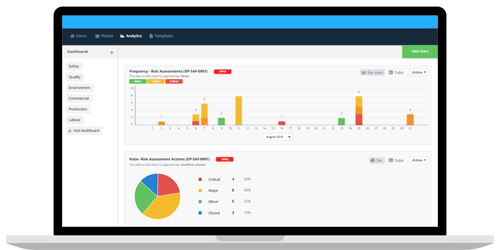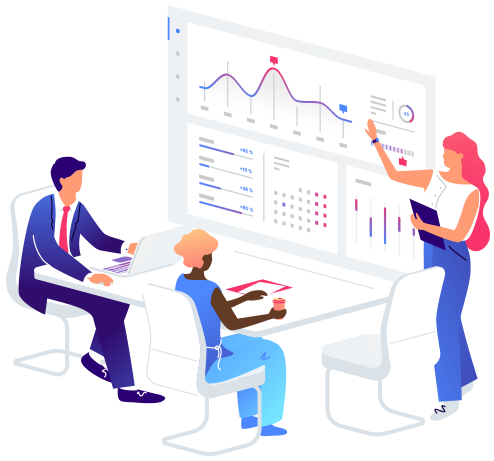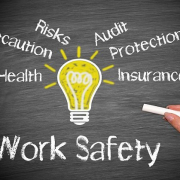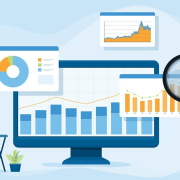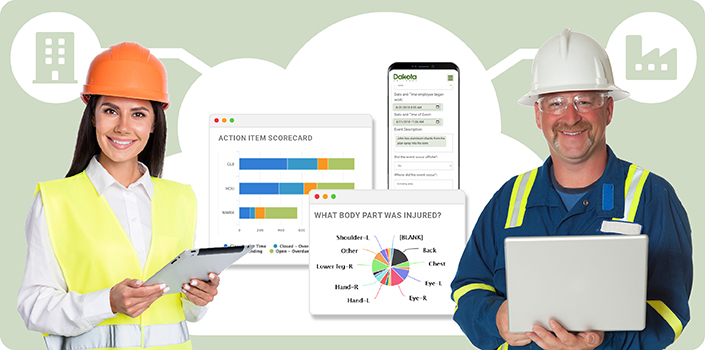Workplace Safety Software: Essential Features for Compliance and Efficiency
Why Employee Safety Software Is Important At Workspace?
Employee safety software is crucial in the workspace as it enhances the overall safety culture and compliance, ensuring that organizations abide by safety regulations and standards. This workplace safety software helps in identifying, managing, and mitigating potential risks and hazards, thus preventing workplace accidents and injuries. By providing real-time data and analytics, it helps organizations to monitor safety performance, track incidents, and implement preventive measures effectively. Furthermore, employee safety software fosters better communication and collaboration among team members, promoting a proactive approach toward safety. It empowers employees by providing them with easy-to-access safety resources, training, and reporting tools, ultimately leading to a safer and more efficient working environment.
About Havteq’s Workspace Safety Software Features
Havteq’s Workspace Safety Software is thoughtfully designed to address the evolving needs of modern workplaces. At its core, this software provides a comprehensive suite of features that empower organizations to create safer, more compliant environments for their teams. The intuitive dashboard streamlines incident reporting, allowing employees to quickly log hazards or near-misses. Real-time alerts and automated workflows ensure that no safety concern goes unnoticed or unaddressed.
Beyond incident management, Havteq’s Workspace Safety Software offers powerful analytics tools that help organizations identify trends and potential risks before they escalate. Customizable checklists and inspection modules support ongoing compliance with industry standards and regulations. Additionally, the system facilitates seamless communication between safety managers and staff, fostering a proactive culture of safety across all levels of the organization.
By integrating these robust features into daily operations, Havteq’s EHS software not only simplifies safety management but also helps build trust and confidence among employees—making workplaces safer for everyone involved.
Key Takeaways
- Workplace safety software is essential for managing and improving safety in the workplace.
- Compliance with regulatory requirements is crucial for ensuring a safe work environment and avoiding penalties.
- Incident reporting and management tools help in identifying and addressing safety issues promptly.
- Risk assessment and mitigation features enable proactive measures to prevent workplace accidents and injuries.
- Training and certification tracking capabilities ensure that employees are adequately trained and qualified for their roles.
Compliance and Regulatory Requirements
Navigating the complex landscape of compliance and regulatory requirements is one of the most significant challenges organizations face in maintaining workplace safety. Various regulatory bodies, such as the Occupational Safety and Health Administration (OSHA) set forth stringent guidelines that organizations must adhere to in order to ensure the safety of their employees. Workplace safety software plays a crucial role in helping organizations stay compliant by automating the tracking and reporting of safety metrics.

For instance, many safety software solutions come equipped with features that allow organizations to monitor compliance with specific regulations in real time. This includes tracking incidents, maintaining records of safety training, and ensuring that safety equipment meets regulatory standards. By automating these processes, organizations can reduce the risk of non-compliance, which can lead to hefty fines and legal repercussions.
Furthermore, the software often includes built-in reminders for upcoming audits or inspections, ensuring that organizations remain proactive rather than reactive in their compliance efforts.
Incident Reporting and Management
Incident reporting is a critical component of workplace safety management, as it provides organizations with valuable insights into potential hazards and areas for improvement. Workplace safety software simplifies the incident reporting process by allowing employees to report incidents quickly and efficiently through user-friendly interfaces. This immediacy not only encourages employees to report incidents but also ensures that data is captured accurately and promptly.

Once an incident is reported, the software facilitates a structured management process that includes investigation, analysis, and follow-up actions. For example, many platforms allow for the categorization of incidents based on severity, type, or location, enabling organizations to identify patterns and trends over time. This data-driven approach helps organizations implement targeted interventions to prevent future incidents.
Risk Assessment and Mitigation
Effective risk assessment is fundamental to any workplace safety program. It involves identifying potential hazards, evaluating the risks associated with those hazards, and implementing measures to mitigate them. Workplace safety software enhances this process by providing tools for conducting thorough risk assessments and documenting findings in a systematic manner.
For instance, many software solutions include customizable risk assessment templates that guide users through the evaluation process. These templates often prompt users to consider various factors such as the likelihood of an incident occurring and the potential consequences should it occur. By standardizing the risk assessment process, organizations can ensure consistency and comprehensiveness in their evaluations.
Furthermore, the software can generate reports that highlight high-risk areas within the organization, allowing management to prioritize resources and interventions effectively. Mitigation strategies can also be tracked within the software, enabling organizations to monitor the implementation of safety measures over time. This ongoing evaluation is crucial for adapting to changing workplace conditions or emerging risks.
By leveraging data analytics capabilities, organizations can assess the effectiveness of their mitigation strategies and make informed adjustments as necessary.
Training and Certification Tracking
Training is a cornerstone of workplace safety, as it equips employees with the knowledge and skills necessary to recognize hazards and respond appropriately. Workplace safety software often includes robust training management features that allow organizations to track employee training requirements, schedules, and certifications. This functionality ensures that all employees receive the necessary training to perform their jobs safely.

Many workplace safety software solutions offer reporting capabilities that allow management to analyze training data across the organization. By identifying trends in training completion rates or areas where employees may be struggling, organizations can refine their training programs to better meet employee needs. This data-driven approach enhances the overall effectiveness of training initiatives and contributes to a safer work environment.
Audit and Inspection Management
Regular audits and inspections are essential for maintaining workplace safety standards and ensuring compliance with regulations. Workplace safety software streamlines this process by providing tools for planning, conducting, and documenting audits and inspections efficiently. With features such as checklists and automated reminders, organizations can ensure that audits are conducted consistently and thoroughly.
During an audit or inspection, users can easily document findings directly within the software, attaching photos or notes as needed. This digital documentation not only simplifies record-keeping but also enhances accountability by creating a clear trail of actions taken during the audit process. Additionally, many software solutions offer analytics capabilities that allow organizations to identify recurring issues or trends across multiple audits, enabling them to address systemic problems proactively.
Post-audit follow-up is another critical aspect of effective audit management. Workplace safety software often includes features for tracking corrective actions identified during audits, ensuring that issues are addressed in a timely manner. By integrating audit management into their overall safety program, organizations can create a continuous feedback loop that drives ongoing improvements in workplace safety.
Emergency Response Planning
In any workplace, having a robust emergency response plan is vital for ensuring employee safety during unforeseen events such as natural disasters, fires, or medical emergencies. Havteq’s Workplace safety software provides tools for developing, implementing, and communicating emergency response plans effectively. These tools often include customizable templates that guide organizations through the planning process.
For instance, organizations can use the software to outline specific emergency procedures tailored to different scenarios, detailing roles and responsibilities for employees during an emergency. By regularly practicing emergency response procedures, organizations can ensure that employees are prepared to act swiftly and effectively when faced with an actual emergency.

Communication is another critical component of emergency response planning. Workplace safety software often includes features for disseminating emergency alerts or notifications to employees in real time. This capability ensures that all employees are informed of potential threats or necessary actions during an emergency situation.
By integrating communication tools into their emergency response plans, organizations can enhance their overall preparedness and minimize risks during crises.
Integration and Scalability
As businesses grow and evolve, their workplace safety needs may change significantly over time. Therefore, it is essential for workplace safety software to be both integrative and scalable. Many modern solutions offer integration capabilities with other business systems such as Human Resources Management Systems (HRMS), Enterprise Resource Planning (ERP) systems, or Learning Management Systems (LMS).
This integration allows for seamless data sharing across platforms, enhancing overall operational efficiency. For example, when an employee completes a training module within an LMS integrated with workplace safety software, their training records can automatically update within the safety system without manual intervention. This not only saves time but also reduces the likelihood of errors associated with data entry across multiple systems.
Scalability is equally important as organizations expand their operations or adapt to new regulatory environments. A scalable workplace safety software solution can accommodate increased user loads or additional functionalities without compromising performance. Organizations should look for solutions that offer modular features or customizable options that can be tailored to their specific needs as they grow. Environmental Health and Safety Software is essential for managing workplace safety and compliance, learn more at https://havteq.com/blog/environmental-health-and-safety-software/. This flexibility ensures that businesses can maintain effective safety management practices regardless of changes in size or complexity.
Conclusion
In conclusion, workplace safety software represents a vital tool for organizations committed to fostering a safe working environment. By addressing compliance requirements, streamlining incident reporting, enhancing risk assessment processes, managing training initiatives effectively, facilitating audits and inspections, planning for emergencies, and offering integration capabilities for scalability, these solutions empower businesses to prioritize employee well-being while optimizing operational efficiency. Contact us to know more about our EHS management software. Call us on +91-9416460450 Or +91-8950505999

